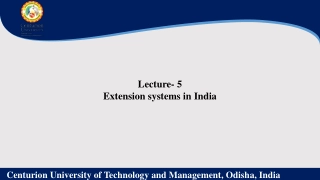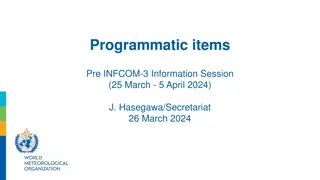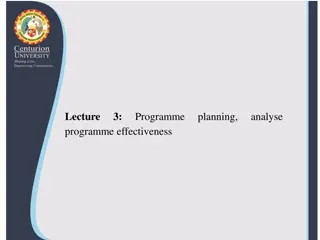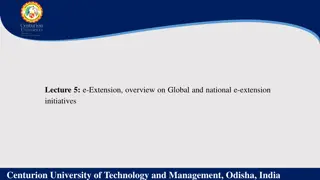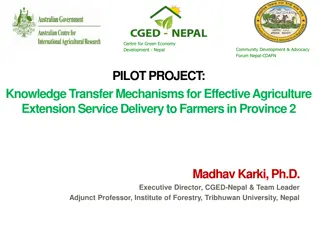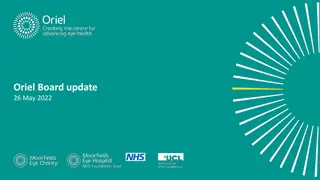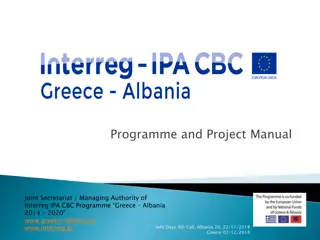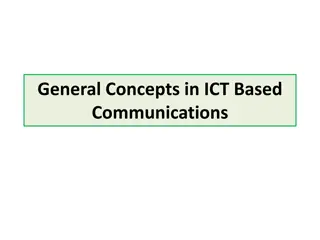Extension Programme Planning
Understanding the elements of a program plan is crucial for effective extension programme planning. The process involves analyzing the situation, setting realistic objectives, defining the target audience, devising a strategy, implementing tactics, creating a calendar, establishing a budget, and evaluating the outcomes. Steps in extension programme planning include reviewing progress, identifying problems, finding solutions, prioritizing, preparing a plan of action, execution, and continuous evaluation. These steps help ensure successful implementation of extension programmes at Centurion University of Technology and Management in Odisha, India.
Download Presentation

Please find below an Image/Link to download the presentation.
The content on the website is provided AS IS for your information and personal use only. It may not be sold, licensed, or shared on other websites without obtaining consent from the author.If you encounter any issues during the download, it is possible that the publisher has removed the file from their server.
You are allowed to download the files provided on this website for personal or commercial use, subject to the condition that they are used lawfully. All files are the property of their respective owners.
The content on the website is provided AS IS for your information and personal use only. It may not be sold, licensed, or shared on other websites without obtaining consent from the author.
E N D
Presentation Transcript
Lecture 4 Extension Programme Planning Centurion University of Technology and Management, Odisha, India
Elements of a Program Plan Situation Objectives Audience Strategy Tactics Calendar/ Timetable Budget Evaluation Centurion University of Technology and Management, Odisha, India
1. Situation- Understanding the situation leads to the conclusion that: Is there a problem or negative situation that needs to be addressed? Ex: Production/marketing Needed to reinforce an ongoing effort and introduction of new technology? Ex: variety, practice 2. Objectives What is the desired outcome? Does it really address the situation? Is it realistic and achievable? Can success be measured in meaningful terms? 3. Audience- Extension programs should be directed toward specific and defined target communities Use research to identify demographics as age, income, social strata, education, existing enterprise, resource use behaviour etc. Centurion University of Technology and Management, Odisha, India
4. Strategy- How, in concept, is an objective going to be achieved? Key themes and message that should be part of programme Plan should contain changes to be achieved in target communities. 5. Tactics- Are nuts and bolts of plan that describe, in sequence, the specific activities that put strategies into operation and help achieve the stated objectives Tactics involve using the tools of communication to reach primary and secondary target communities with extension inputs. 6. Calendar/Timetable Determining the proper sequence of activities Compiling a list of steps that must be completed to produce a desirable change in target communities. Centurion University of Technology and Management, Odisha, India
7. Budget- No program plan is complete without a budget Part of strategy to ensure flow of finance as per the programme The anticipated outcomes/outputs are directly related to financial input 8. Evaluation- Objectives must be measurable in some way to show program accomplished its purpose Types of evaluation : Ex-ante, concurrent and Expost facto Centurion University of Technology and Management, Odisha, India
STEPS IN EXENSION PROGRAMME PLANNING Review of progress and projection of plans Analysis of Situation Identification of problems Finding solutions to problems Selecting problems and determining priorities Preparing a plan of action or Annual plan of work Carrying out the plan Continuous checking and evaluation of result Centurion University of Technology and Management, Odisha, India
Centurion University of Technology and Management, Odisha, India
Types of planning Nature Strategic Tactical Operational Contingency Managerial level Top level Middle level Lower level Time Long term Intermediate term Short term Use Single use Standing plan Based on Nature Strategic Plan:formulated by top level management for a long period of time of five years or more. They decide the major goals and policies to achieve Tactical Plan:concerned with integration of various organizational units. Involves resource utilization to achieve the strategic goals Operational Plan:Formulated by lower management for short term period. Concerned with the day to day operations of the organization. It is detailed and specific. Contingency Planning: Made when something unexpected happens or when something needs to be changed Centurion University of Technology and Management, Odisha, India
On the basis of time Long Term Plan: Determines the path for research and development institutions to reach their goals. It also reinforces and makes corrections to the goals as the plan progresses Intermediate Plan: Covers 6 months to 2 years. It outlines how the strategic plan will be pursued. Short-term Plan: Involves pans for a few weeks or at most a year. Allocates resources for the day-today activities and management within the strategic plan. Centurion University of Technology and Management, Odisha, India
On the basis of use Single Plan: Connected with some special problems. These plans end the moment problem is solved. They are further re-created whenever required Standing Plan: Formulated once and they are repeatedly used. Continuously guide the extension professionals. Include mission, policies, objective, rules and strategy Centurion University of Technology and Management, Odisha, India
Conclusion In practice the steps provide us insight regarding planning the programme and programme planning Appropriate planning involving holistic approach leads to overall development Centurion University of Technology and Management, Odisha, India




